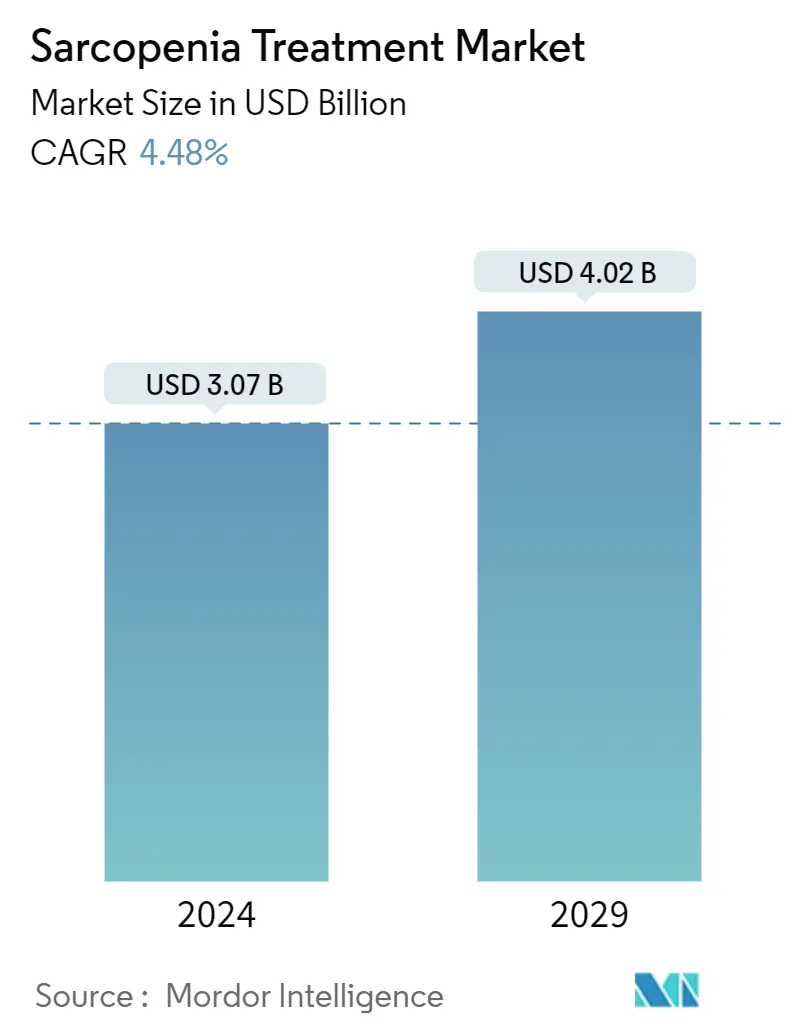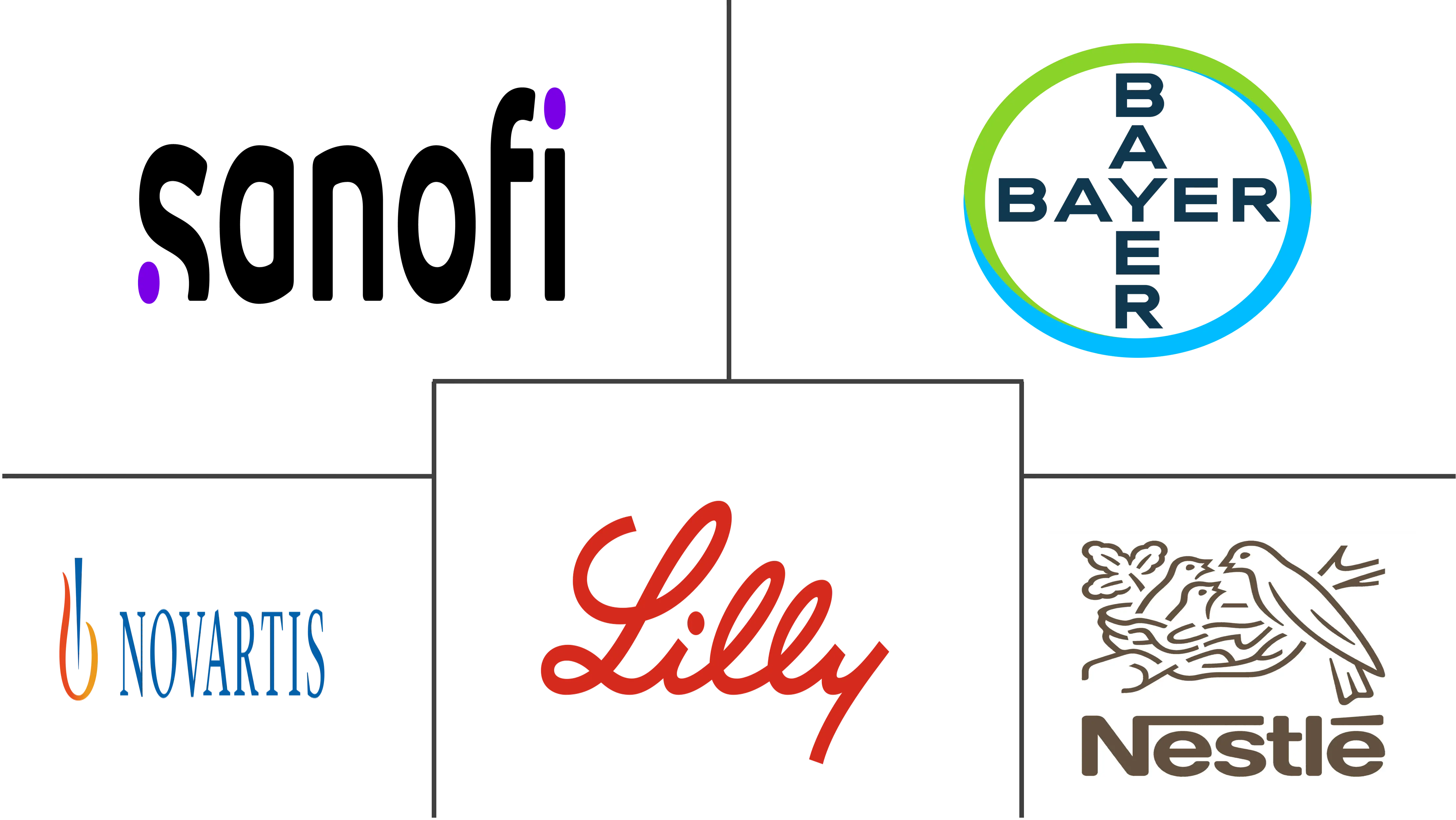Market Size of Sarcopenia Treatment Industry

| Study Period | 2019-2029 |
| Market Size (2024) | USD 3.07 Billion |
| Market Size (2029) | USD 4.02 Billion |
| CAGR (2024 - 2029) | 4.48 % |
| Fastest Growing Market | Asia-Pacific |
| Largest Market | North America |
Major Players
*Disclaimer: Major Players sorted in no particular order |
Sarcopenia Treatment Market Analysis
The Sarcopenia Treatment Market size is estimated at USD 3.07 billion in 2024, and is expected to reach USD 4.02 billion by 2029, growing at a CAGR of 4.48% during the forecast period (2024-2029).
Factors such as the rise in the geriatric population and the increase in malnutrition, coupled with vitamin deficiency globally, are expected to increase the need for sarcopenia treatment, fueling the market growth over the study period. For instance, according to a study published in August 2022 in Nutrients Journal, older people had a higher risk of developing Sarcopenia, emphasizing the need for proper treatment and nutrition intake. Moreover, according to the World Population Prospects 2022 report by the United Nations, the global population aged 65 years or above is projected to rise from 10% in 2022 to 16% in 2050. As the senior population is more prone to acquiring muscle issues due to their age, the demand for sarcopenia treatment is expected to increase with the aging population, contributing to market growth over the study period.
Additionally, an increase in research studies and pipeline assets by the key players focusing on sarcopenia treatment is expected to augment the market growth over the study period. For instance, Research Square's article published in February 2022 highlighted the association of Sarcopenia with vitamin D, protein, and calcium intake. Among these nutrients, calcium has the most significant impact. Also, an article published by the Examine in January 2022 examined the association between vitamin B12 and muscle health in older adults. In this study, the investigators assessed several markers of muscle health, including appendicular (legs and arms) skeletal muscle mass, handgrip strength, and performance on a physical test battery. The study compared the vitamin B12 insufficiency associated with low appendicular skeletal muscle mass. Hence, the increased adoption of Vitamin B12, Calcium and Vitamin D among older patients in treating Sarcopenia will likely boost the market growth.
Furthermore, a low-quality diet and muscle weakness are significant factors contributing to Sarcopenia. Increasing the uptake of proper nutrition and vitamins may significantly reduce the risk of Sarcopenia.
According to an article published by Frontiers in Endocrinology in June 2022, vitamin D supplementation improved handgrip strength in postmenopausal women. The supplement did not improve mobility but enhanced muscle strength, particularly in postmenopausal women over 60 without calcium supplementation or whose baseline vitamin D is >75 nmol/L (30 ng/ml). Hence, such research studies depicting the importance of nutritional intake in treating Sarcopenia are expected to drive market growth over the forecast period.
Thus, due to the increase in the geriatric population, the rise in research studies to develop sarcopenia treatment products, and the surge in advantages offered by sarcopenia treatment products, the market studied is expected to witness significant growth over the study period. However, the non-availability of new drugs will hinder the market's growth over the forecast period.
Sarcopenia Treatment Industry Segmentation
Sarcopenia is a term used to describe the loss of muscle mass, strength, and function associated with aging. Currently, there are no FDA-approved medications for the treatment of sarcopenia. The effects of exercise and nutritional supplementation on patients with sarcopenia have been examined in numerous studies. The sarcopenia treatment market is segmented by treatment type, distribution channel, and geography. Based on the treatment type, the market is segmented into protein supplements, vitamin B12 Supplements, vitamin D and calcium supplements, and other treatment types. Other treatment types include cell therapy, gene therapy, and hormone therapy. By distribution channel, the market is segmented by hospital pharmacies, retail pharmacies, online pharmacies, and other distribution channels. Other distribution channels include hypermarkets, supermarkets, clinic pharmacies, and drug stores. The report also covers the market sizes and forecasts for the sarcopenia treatment market in major countries across different regions.
For each segment, the market size is provided in terms of value (USD).
| By Treatment Type | |
| Protein Supplements | |
| Vitamin B12 Supplements | |
| Vitamin D and Calcium Supplements | |
| Other Treatment Types |
| By Distribution Channel | |
| Hospital Pharmacies | |
| Retail Pharmacies | |
| Online Pharmacies | |
| Other Distribution Channels |
| Geography | ||||||||
| ||||||||
| ||||||||
| ||||||||
| ||||||||
|
Sarcopenia Treatment Market Size Summary
The sarcopenia treatment market is poised for significant growth, driven by the increasing geriatric population and the rising prevalence of malnutrition and vitamin deficiencies worldwide. As older adults are more susceptible to muscle-related issues, the demand for effective sarcopenia treatments is expected to rise. This demand is further bolstered by ongoing research and development activities focusing on the role of nutrients such as vitamin D, calcium, and protein in muscle health. Studies highlighting the benefits of nutritional intake, including protein supplementation and exercise, are anticipated to propel market expansion. The market's growth is also supported by strategic initiatives from key players and increased awareness of sarcopenia, which is expected to enhance the adoption of treatment products.
North America is expected to maintain a significant position in the sarcopenia treatment market due to its advanced healthcare infrastructure and technological advancements. The region's growing geriatric population, coupled with numerous clinical studies demonstrating the efficacy of supplements, is likely to drive market growth. Government support for research and development in sarcopenia treatments further contributes to this growth. The market is characterized by a semi-consolidated nature, with key players such as Nestlé SA, Sanofi SA, and Eli Lilly and Company actively engaging in strategic collaborations and clinical studies to strengthen their portfolios. These efforts, along with regulatory approvals for new treatments, are expected to foster innovation and expand the market landscape over the forecast period.
Sarcopenia Treatment Market Size - Table of Contents
-
1. MARKET DYNAMICS
-
1.1 Market Overview
-
1.2 Market Drivers
-
1.2.1 Increasing Geriatric Population
-
1.2.2 Rise in Malnutrition and Vitamin Deficiency in Developing Countries
-
-
1.3 Market Restraints
-
1.3.1 Non-availability of New Drugs
-
-
1.4 Porter's Five Forces Analysis
-
1.4.1 Bargaining Power of Suppliers
-
1.4.2 Bargaining Power of Buyers/Consumers
-
1.4.3 Threat of New Entrants
-
1.4.4 Threat of Substitute Products
-
1.4.5 Intensity of Competitive Rivalry
-
-
-
2. MARKET SEGMENTATION (Market Size by Value - USD)
-
2.1 By Treatment Type
-
2.1.1 Protein Supplements
-
2.1.2 Vitamin B12 Supplements
-
2.1.3 Vitamin D and Calcium Supplements
-
2.1.4 Other Treatment Types
-
-
2.2 By Distribution Channel
-
2.2.1 Hospital Pharmacies
-
2.2.2 Retail Pharmacies
-
2.2.3 Online Pharmacies
-
2.2.4 Other Distribution Channels
-
-
2.3 Geography
-
2.3.1 North America
-
2.3.1.1 United States
-
2.3.1.2 Canada
-
2.3.1.3 Mexico
-
-
2.3.2 Europe
-
2.3.2.1 Germany
-
2.3.2.2 United Kingdom
-
2.3.2.3 France
-
2.3.2.4 Italy
-
2.3.2.5 Spain
-
2.3.2.6 Rest of Europe
-
-
2.3.3 Asia-Pacific
-
2.3.3.1 China
-
2.3.3.2 Japan
-
2.3.3.3 India
-
2.3.3.4 Australia
-
2.3.3.5 South Korea
-
2.3.3.6 Rest of Asia-Pacific
-
-
2.3.4 Middle East &Africa
-
2.3.4.1 GCC
-
2.3.4.2 South Africa
-
2.3.4.3 Rest of Middle East & Africa
-
-
2.3.5 South America
-
2.3.5.1 Brazil
-
2.3.5.2 Argentina
-
2.3.5.3 Rest of South America
-
-
-
Sarcopenia Treatment Market Size FAQs
How big is the Sarcopenia Treatment Market?
The Sarcopenia Treatment Market size is expected to reach USD 3.07 billion in 2024 and grow at a CAGR of 4.48% to reach USD 4.02 billion by 2029.
What is the current Sarcopenia Treatment Market size?
In 2024, the Sarcopenia Treatment Market size is expected to reach USD 3.07 billion.

